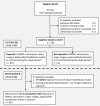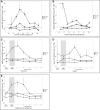Kinetics of Urinary Cell Cycle Arrest Markers for Acute Kidney Injury Following Exposure to Potential Renal Insults
- PMID: 29189343
- PMCID: PMC5821475
- DOI: 10.1097/CCM.0000000000002847
Kinetics of Urinary Cell Cycle Arrest Markers for Acute Kidney Injury Following Exposure to Potential Renal Insults
Abstract
Objectives: Urinary tissue inhibitor of metalloproteinase-2 and insulin-like growth factor binding protein 7 predict the development of acute kidney injury following renal insults of varied aetiology. To aid clinical interpretation, we describe the kinetics of biomarker elevations around an exposure.
Design: In an ancillary analysis of the multicenter SAPPHIRE study, we examined the kinetics of the urinary [tissue inhibitor of metalloproteinase-2]•[insulin-like growth factor binding protein 7] in association with exposure to common renal insults (major surgery, IV radiocontrast, vancomycin, nonsteroidal anti-inflammatory drugs, and piperacillin/tazobactam).
Setting: Thirty-five sites in North America and Europe between September 2010 and June 2012.
Patients: Seven hundred twenty-three critically ill adult patients admitted to the ICU.
Interventions: None.
Measurements and main results: We compared the urinary [tissue metalloproteinase-2]•[insulin growth factor binding protein 7] kinetics from the day prior to exposure up to 5 days after exposure in patients developing acute kidney injury stage 2-3, stage 1, or no acute kidney injury by Kidney Disease Improving Global Outcome criteria. Among the 723 patients, 679 (94%) had at least one, 70% had more than one, and 35% had three or more exposures to a known renal insult. There was a significant association between cumulative number of exposures up to study day 3 and risk of acute kidney injury (p = 0.02) but no association between the specific type of exposure and acute kidney injury (p = 0.22). With the exception of radiocontrast, patients who developed acute kidney injury stage 2-3 after one of the five exposures, had a clear rise and fall of urinary [tissue inhibitor of metalloproteinase-2]•[insulin-like growth factor binding protein 7] from the day of exposure to 24-48 hours later. In patients without acute kidney injury, there was no significant elevation in urinary [tissue inhibitor of metalloproteinase-2]•[insulin-like growth factor binding protein 7].
Conclusions: Exposure to potential renal insults is common. In patients developing acute kidney injury stage 2-3, the kinetics of urinary [tissue inhibitor of metalloproteinase-2]•[insulin-like growth factor binding protein 7] matched the exposure except in the case of radiocontrast.
Conflict of interest statement
Dr. Ostermann disclosed that the original Sapphire study was funded by Astute Medical. She received grant support from Fresenius Medical Care. Dr. Forni received funding from Astute Medical and Orthodox Clinical Diagnostic (lecture fees). Dr. Bagshaw received funding from Baxter Healthcare. He was also supported by a Canada Research Chair in Critical Care Nephrology. Dr. Joannidis received speaker´s fees from Astute Medical. Dr. Shi received funding from Astute Medical and disclosed that her husband also consults for Astute Medical. Dr. Kashani’s institution received funding from Astute Medical. Dr. Honore’s institution received funding from Baxter. Dr. Chawla disclosed that he is an employee of La Jolla Pharmaceutical. He also disclosed that he and his institution received funding from Astute Medical. Dr. Kellum and his institution received funding from Astute Medical. The remaining authors have disclosed that they do not have any potential conflicts of interest.
Figures


References
-
- Hoste EA, Bagshaw SM, Bellomo R, et al. Epidemiology of acute kidney injury in critically ill patients: The multinational AKI-EPI study. Intensive Care Med 2015; 41:1411–1423. - PubMed
-
- Mehta RL, Cerdá J, Burdmann EA, et al. International Society of Nephrology’s 0 by 25 initiative for acute kidney injury (zero preventable deaths by 2025): A human rights case for nephrology. Lancet 2015; 385:2616–2643. - PubMed
-
- Bellomo R, Kellum JA, Ronco C. Acute kidney injury. Lancet 2012; 380:756–766. - PubMed
-
- Kerr M, Bedford M, Matthews B, et al. The economic impact of acute kidney injury in England. Nephrol Dial Transplant 2014; 29:1362–1368. - PubMed
Publication types
MeSH terms
Substances
LinkOut - more resources
Full Text Sources
Other Literature Sources
Miscellaneous

